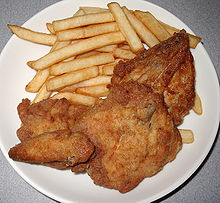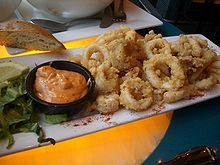- Deep frying
-
Deep frying is a cooking method in which food is submerged in hot oil or fat. This is normally performed with a deep fryer or chip pan; industrially, a pressure fryer or vacuum fryer may be used.
Deep frying is classified as a dry cooking method because no water is used. Due to the high temperature involved and the high heat conduction of oil, it cooks food extremely quickly.
Contents
Technique
If performed properly, deep-frying does not make food excessively greasy, because the moisture in the food repels the oil. The hot oil heats the water within the food, steaming it from the inside out; oil cannot go against the direction of this powerful flow because (due to its high temperature) the water vapor pushes the bubbles toward the surface.[1] As long as the oil is hot enough and the food is not immersed in the oil for too long, oil penetration will be confined to the outer surface. However, if the food is cooked in the oil for too long, much of the water will be lost and the oil will begin to penetrate the food. The correct frying temperature depends on the thickness and type of food, but in most cases it lies between 175 and 190 °C (345–375 °F).
Oil deterioration
Overheating or over-using the frying oil leads to formation of rancid-tasting products of oxidation, polymerization, and other deleterious, unintended or even toxic compounds such as acrylamide (from starchy foods). Deep-frying under vacuum helps to significantly reduce acrylamide formation,[2] but this process is not widely used in the food industry due to the high investment cost involved.
Some useful tests and indicators of excessive oil deterioration are the following:
- Sensory: Darkening, smoke, foaming, thickening, rancid taste and unpleasant smell when heating.
- Laboratory: Acidity, anisidine value, viscosity, total polar compounds, polymeric triglycerides.
Instruments that indicate total polar compounds, currently the best single gauge of how deep-fried an object is, are available with sufficient accuracy for restaurant and industry use.
Disadvantages
Deep frying produces large amounts of waste oil, which must be properly disposed. Waste oil is increasingly being recycled into biodiesel.
Some deep fry shortenings contain trans fat.
Cooking oil is flammable, and fires may be caused by it igniting at too high a temperature. Attempts to extinguish an oil fire with water cause the water to flash into steam due to the high heat of the oil, in turn sending the burning oil in all directions and thus aggravating the fire. Instead, oil fires must be extinguished via fire extinguisher or by smothering. Other means of extinguishing an oil fire include application of dry powder (e.g., baking soda, salt) or fire fighting foam. Most commercial deep fryers are equipped with automatic fire suppression systems using foam.
See also
- Banana chips
- Deep-fried Twinkie
- Deep-fried Mars Bar
- Deep-fried pizza
- Finger steaks
- French fried potatoes
- Fried pickles
- "Toasted" ravioli
References
- ^ This, Hervé (2006). Molecular Gastronomy. New York: Columbia University Press. pp. 63. ISBN 978-0-231-13312-8.
- ^ C. GRANDA, R.G. MOREIRA, S.E. TICHY (2004) Reduction of Acrylamide Formation in Potato Chips by Low-temperature Vacuum Frying Journal of Food Science 69 (8), 405–411.
External links
Cooking techniques Dry ConductionConvectionRadiationWet High heatLow heatIndirect heatFat-based High heatBlackening · Browning · Frying (Deep frying · Pan frying · Shallow frying · Stir frying (bao)) · SautéingLow heatGentle frying · SweatingMixed medium Device-based Non-heat See also Categories:- Cooking techniques
- Scottish cuisine
Wikimedia Foundation. 2010.




